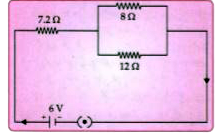A battery of internal resistance 3Ω is connected to 20Ω resistor and the potential difference across the resistor is 10V. If another resistor 30Ω is connected in series with the first resistor and battery is again connectecl to the combination, then calculate the e.m.f and terminal potential difference across the combination..Solution in Kannada
Here r=3Ω,V=10V,R=20Ω,ε=?
Case 1) :
we know that
I=εR+r
But V=IR⇒I=VR
VR=εR+r
ε=V(R+r)R=10(20+3)20=23020
ε=11.5V
Case 2) : Rs=R1+R2=20+30=50Ω
1=εRs+r
But V=IRS
I=VRs
VRs=εRs+r
V=εRsRs+r
V=εRsRs+r
=11.5×5050+3=57553
V=10.849V
Similar Questions
(a) Three resistor 1Omega ,2Omega, and 3Omega are combined in series. What is the total resistance of the ombination ? (b) If the combination is connected to a battery of emf 12 V and negligible internal resistance, obtain the potential drop across each resistor.
View Solution(a) Three resistor 1Ω,2Ω,and3Ω are combined in series. What is the total resistance of the ombination ?
(b) If the combination is connected to a battery of emf 12 V and negligible internal resistance, obtain the potential drop across each resistor.
View SolutionThe potential difference between the terminals of a battery of e.m.f 6.0V and internal resistance 1Ω drops to 5.8V when connected across an external resistor. Find the resistance of the external resistor.
View SolutionIf the combination is connected to a battery of emf 12 V and negligible internal resistance, obtain the potential drop across each resistor.
View SolutionThree resistors are connected to a 6 V battery as shown in the figure given below :

Calculate :
potential difference across the 7.2Ω resistor.
View SolutionThree resistors are connected to a 6 V battery as shown in the figure Calculate: potential difference across the 7.2 ohm resistor
View SolutionA resistor of 6 Omega is connected in series with another resistor of 4 Omega . A potential difference of 20 V is applied across the combination. Calculate : the current in the circuit,
View SolutionA resistor of 6 Ω is connected in series with another resistor of 4 Ω. A potential difference of 20 V is applied across the combination. Calculate :
the potential difference across the 6 Ω resistor.
View Solution
